What Lies Beneath: The Hidden Layers of Your Roof
A tile roof is like a well-dressed secret agent. Sure, the tiles are what you see, but underneath them lies a network of crucial components that keep your office safe and dry. Two of the most critical yet often overlooked elements are the underlayment and the roof deck.The underlayment is a waterproof barrier that sits beneath the tiles, acting as the last line of defense against leaks. Over time, however, it can deteriorate due to heat, moisture, and the general wear-and-tear of existing in a world where nature is always trying to reclaim what’s hers. If your underlayment fails, you might not know it right away. It starts with a little moisture creeping in, then some mold, and before you know it, your ceiling has an unsolicited indoor waterfall.
And then there’s the roof deck—the sturdy foundation that supports everything above. Think of it as the skeleton of your roof, and just like any skeleton, if it starts to weaken, the whole structure is at risk. Rot, pests, and water damage can quietly eat away at the deck, turning what once was a fortress into something about as reliable as a house of cards in a wind tunnel.
How Time and Weather Work Against You
You wouldn’t expect a car to run flawlessly for 30 years without maintenance, but somehow, people expect their roofs to do just that. Tile roofs are incredibly durable, but they’re not immortal. Beneath those tiles, time and weather are teaming up to stage a slow but effective coup against your underlayment and decking.Heat is a major culprit. The relentless cycle of the sun baking your roof all day and the cooler temperatures at night cause materials to expand and contract. This process gradually weakens underlayment and makes it brittle. Once that happens, even a small amount of moisture can seep through, and moisture has a habit of making itself at home where it doesn’t belong.
Rain and wind, meanwhile, do their own brand of mischief. Water sneaks into tiny cracks, and if the underlayment isn’t in top shape, it’s only a matter of time before damage spreads to the decking. And let’s not even get started on storm season, where gusty winds can turn minor vulnerabilities into major leaks.
Then there’s debris—leaves, branches, and whatever else the wind decides to hurl onto your roof. This buildup can trap moisture, encouraging decay and leading to clogged drainage pathways, ensuring that water stays exactly where you don’t want it.
The Restoration Advantage: More Than Just a Facelift
Restoring a tile roof isn’t just about making it look pretty—it’s about reinforcing the entire system. A proper restoration involves replacing degraded underlayment, reinforcing the decking, and ensuring that every tile is doing its job correctly.By addressing hidden damage before it turns into a full-blown catastrophe, restoration can save you from the dreaded “bucket in the hallway” scenario. A compromised underlayment may not announce its failure right away, but when it does, it often comes in the form of ceiling stains, mold, or that unmistakable musty smell that signals bad news.
A well-done restoration also improves insulation and energy efficiency. If your office feels like an oven in the summer and a meat locker in the winter, an aging roof could be to blame. Modern materials provide better temperature regulation, which means a more comfortable workspace and lower energy bills.
Structural Integrity: Because No One Wants a Surprise Skylight
Ignoring the hidden damage beneath your office’s tile roof is like ignoring a slow leak under the kitchen sink—sure, everything looks fine now, but give it time, and you’ll have an expensive mess on your hands. One of the biggest risks of roof neglect is the gradual weakening of the structure itself.Once moisture starts invading the decking, the wood begins to soften and weaken. Over time, this can lead to sagging areas, making your roof look less like a protective cover and more like a sad, drooping hat. Worse yet, unchecked decay can cause sections to collapse, and unless you’re in the market for an impromptu sunroof, that’s not a feature anyone wants.
Pests also see a deteriorating roof as an open invitation. Once moisture has softened the decking, termites, carpenter ants, and even small rodents can chew their way inside, setting up their own little ecosystem in your office. Before you know it, you’re dealing with both structural damage and an unwelcome wildlife problem.
Why Restoration Beats Costly Emergency Repairs
When it comes to your roof, waiting for something to go wrong before taking action is a guaranteed way to spend more money than necessary. A full roof replacement is significantly more expensive than proactive restoration. By addressing wear and tear early, you avoid catastrophic failures and extend the life of your existing roof by decades.Think of it like dental care: regular checkups and the occasional filling keep your teeth in good shape, but neglect things for too long, and suddenly, you’re looking at a root canal—or worse, dentures. The same principle applies to your office roof. Small issues can be repaired easily, but let them fester, and you’ll be looking at a full-scale replacement that disrupts business operations and drains your budget.
The Unexpected Benefits of a Well-Maintained Roof
Aside from preventing catastrophic failures, restoring your roof has additional benefits that might not be obvious at first glance. A properly maintained tile roof contributes to better energy efficiency, reducing cooling and heating costs. Your HVAC system doesn’t have to work as hard when your building is properly insulated from the top down.Then there’s curb appeal. A roof that looks pristine tells clients, employees, and business partners that you care about your property. It also helps maintain property value—should you ever decide to sell, a well-maintained roof is a major selling point.
And let’s not forget the peace of mind. Knowing that your office isn’t secretly rotting from above means one less thing to worry about. No surprise leaks. No sudden repair bills. No mysterious puddles forming after a storm. Just a solid, reliable roof doing its job.
Raising the Roof (Without Breaking the Bank)
Your office’s tile roof isn’t just there for decoration—it’s a complex system that requires care and attention to perform at its best. While tiles may be the most visible part, the real magic (or disaster) happens beneath the surface.By investing in restoration, you’re not just sprucing up appearances—you’re reinforcing the very thing that keeps your workplace safe, dry, and structurally sound. Regular maintenance and timely repairs mean fewer expensive surprises, better energy efficiency, and a roof that can continue doing its job for years to come.
So, before you assume everything’s fine just because the tiles are still in place, remember: a little proactive care now can save you from a much bigger headache down the road. And if your office’s roof could talk, it would probably thank you for the upkeep—right before reminding you to check on the gutters.
Article kindly provided by briscoroofing.net.au/tile-roof-restorations/



